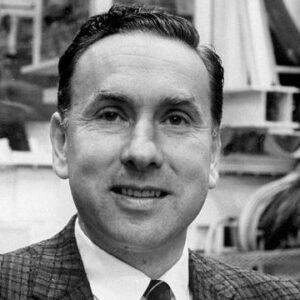American physicist Robert Hofstadter was known for his discoveries about how nucleons are put together. His in-depth study of electron scattering in atomic nuclei led to the discovery of the size and shape of the proton and the neutron. He shared the 1961 Nobel Prize in Physics with Rudolf Mossbauer for this work. He was born into a Jewish family in New York. As he got older, he became a very smart student who did well in science and math. He got an honors degree from City College of New York and was given a Charles A. Coffin Foundation Fellowship to go to graduate school at Princeton University. By the time he was 23, he had a Ph.D. and was working as a physicist at the National Bureau of Standards during World War II. After the war, he became a professor. He worked at Princeton University for a while, where he did research on the Compton effect and crystal conduction counters. After he left Princeton, he went to Stanford University, where he worked on measuring how electrons scatter. Later in his career, he became interested in astrophysics and was a big part of making the Compton Gamma Ray Observatory happen.
Early years and childhood
Robert Hofstadter was born in New York City on February 5, 1915. His parents, Louis Hofstadter, a salesman from Poland, and Henrietta Koenigsberg were both born in Poland. The Jews were his family.
After going to elementary and high school in New York City, he went to the City College of New York and got a B.S. with honors in 1935. He got the Kenyon Prize in Mathematics and Physics because he was a good student.
The General Electric Company also gave him the Coffin Fellowship, which let him go to graduate school at Princeton University and study physics. In 1938, he went to that school and got both an M.A. and a Ph.D.
After getting his Ph.D. at age 23, he was given a Procter Fellowship to do postdoctoral work at Princeton University in 1938 and 1939. During this time, he started studying how light moves through willemite crystals, which led to his later work.
In 1939, he got the Harrison Fellowship at the University of Pennsylvania, where he did more work after finishing his Ph.D. There, he met L. I. Schiff, who became his longtime friend. At Penn, he helped build a big Van de Graaff machine that was used for nuclear research.
Robert Hofstadter’s Career
He worked as a physicist at the National Bureau of Standards during World War II. There, he was a key part of making the proximity fuse, a weapon used to set off anti-aircraft shells and other types of artillery shells. During the war, he also worked at the Norden Laboratory Corporation.
After the war was over, he went back to school. In 1946, he became a professor at Princeton, where he mostly studied infrared rays, photoconductivity, crystal counters, and scintillation counters. In 1948, he put in a patent application for a thallium-activated sodium iodide gamma-ray detector.
In 1950, he left Princeton to become an Associate Professor of Physics at Stanford University. There, he began studying how electrons scatter, kept working on scintillation counters, and made new neutron and X-ray detectors.
From 1953 on, he mostly worked on measuring how electrons scatter. With the help of his students and other scientists, he looked at how the changes in atomic nuclei were spread out. He also used the linear electron accelerator to measure and study the parts of atomic nuclei.
In 1956, he published a paper called “Electron Scattering and Nuclear Structure” in the journal “Reviews of Modern Physics.” In this paper, he came up with the name “Fermi” and the symbol “FM” to honor the Italian physicist Enrico Fermi, who was one of the first people to study nuclear physics. Nuclear physicists and particle physicists use the term a lot.
In 1958 and 1959, he was a Guggenheim Fellow and took a year off to work at the CERN in Geneva, Switzerland. In 1985, he quit his job at Stanford.
In the last few years of his life, he became very interested in astrophysics and helped design and build the Compton Gamma Ray Observatory’s EGRET gamma-ray telescope.
Works of note
Most people remember Robert Hofstadter for his work on how electrons scatter in atomic nuclei. He not only found that protons and neutrons, which are the basic parts of the nuclei of atoms, have a set size and shape, but he also figured out what those sizes are. He also made the first picture of the structure of the nucleus of an atom that was “reasonably consistent.”
Awards & Achievements
In 1961, Robert Hofstadter got a part of the Nobel Prize in Physics “for his pioneering studies of electron scattering in atomic nuclei and for the discoveries he made about the structure of nucleons as a result.”
In 1986, he was given the National Medal of Science as a reward for his work.
Personal History and Legacies
In 1942, Robert Hofstadter tied the knot with Nancy Givan. There were three kids in the family. Douglas, his son, won a Pulitzer Prize.
He died of a heart attack in Stanford, California, on November 17, 1990, when he was 75 years old.
Estimated Net worth
Robert is one of the wealthiest and most well-known physicists. Based on what we found on Wikipedia, Forbes, and Business Insider, Robert Hofstadter has a net worth of about $1.5 million.


